- About Archives
- About SAA
- Careers
- Education
- Publications
- Advocacy
- Membership
The Annual meeting is quickly approaching and we are looking forward to our Section meeting on Friday afternoon from 12:30 - 2:30 pm. We will be having small group discussions facilitated by members of the Section Steering committee discussing the emerging issues in the field of academic archives. We will also hear an update on recent SAA Council activity and will introduce your new Section leadership. We look forward to seeing you in the Big Easy!
The Nominating Committee for the section is pleased to annouce the results of elections for leadership. Elected to the Vice-Chair/Chair Elect position is Christina Zamon of Emerson College. Rebecca Goldman (La Salle University) and Jordan Steele (Johns Hopkins University) were elected to Steering Committee positions. Congratulations! Thanks to all section members who ran for positions - the slate was nice and full this year! And thank you to all who voted as that is an important contribution to the section.
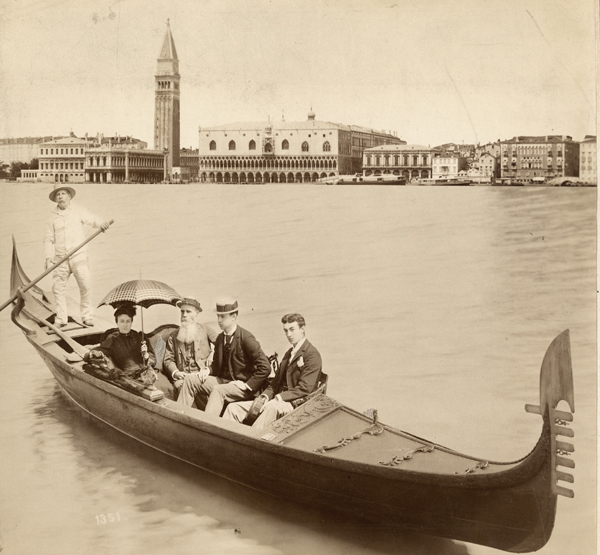
The Syracuse University Archives is pleased to announce the completion of the processing of the George Fisk Comfort Family Collection, which was made possible through a grant from The Gladys Krieble Delmas Foundation.
The collection contains a significant amount of material from George Fisk Comfort (1833-1910), the first dean of the College of Fine Arts at Syracuse University. He also was highly involved in the effort to establish the Metropolitan Museum of Art in New York City as well as what is now the Everson Museum of Art in Syracuse.
Comfort was hired as a professor of modern languages, literature, and aesthetics at Syracuse University in 1872, one year after the institution opened its doors. He pushed for a more formalized study of fine arts at the University, and with the support of the administration, he began the College of Fine Arts in 1873. The College was the first American institution to offer both Bachelor’s and Master’s degrees in fine arts. Although the College of Fine Arts no longer exists in its original form, its essence can be seen in the College of Visual and Performing Arts, the College of Architecture, and the History of Arts program in the College of Arts and Sciences.
The George Fisk Comfort Family Collection, dating from 1822 to 1954, includes correspondence, photographs, writings, and other documents from George Fisk Comfort, his grandfather, father, wife, son, and various other relatives. George Fisk Comfort is not the only notable figure in the collection. His father, a Methodist minister, was at the center of a controversial ecclesiastical trial after allowing the testimony of an African American to be used against a white parishioner in the 1830s. Comfort’s wife, Anna Manning Comfort, was a graduate of the first class from the New York Medical College for Women and the first licensed female practitioner in Connecticut. The four generations of the Comfort family represented in this collection provide an interesting cross section of a progressive American family during the late 19th and early 20th centuries.
Various items such as letters and family photographs were digitized and are available to view in the EAD finding aid. For more information on this collection please contact archives@syr.edu.
Submitted by Meg Mason, Assistant Archivist.
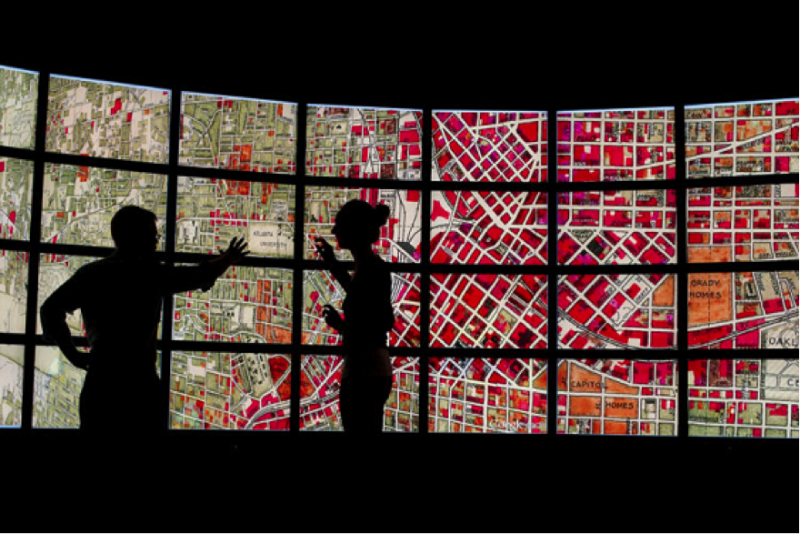
The Georgia State University Library is finishing up an NHPRC funded project to digitize a portion of our Professional Air Traffic Controllers Organization (PATCO) records from the Southern Labor Archives. In a two-year period, over 170,000 individual pages or 2,600 total items were added to our Digital Collections open for public research. We publicized our work on this sizeable project through the library’s blog, professional publications and speaking engagements and are very excited about its successful completion!
Now work continues on Planning Atlanta: A New City in the Making, 1930s-1990s, for which GSU recently received grant funding from the National Endowment for the Humanities to digitize more maps, unique publications and create oral histories involving Atlanta’s built environment. The generous grant will give us the opportunity to do much more with technology, namely Google Earth overlays that will show the evolution of Atlanta’s urban landscape over time by comparing historical maps with recent satellite images. This collection includes 1,550 rare and historically significant City of Atlanta and Atlanta Regional Commission city planning maps, as well as 250 planning publications that will be available for public research. The collection will be contextualized with city photographs, oral histories and housing datasets, and it will be a great tool for students and teachers alike who are studying urban renewal and the challenges faced by large cities.
We have also recently digitized over 50 years of The Georgia State University Signal, our student newspaper that has been in production from 1926 to present day, from our University Archives.
Submitted by Library Tech—Digital Projects, Kelly M. Pepper
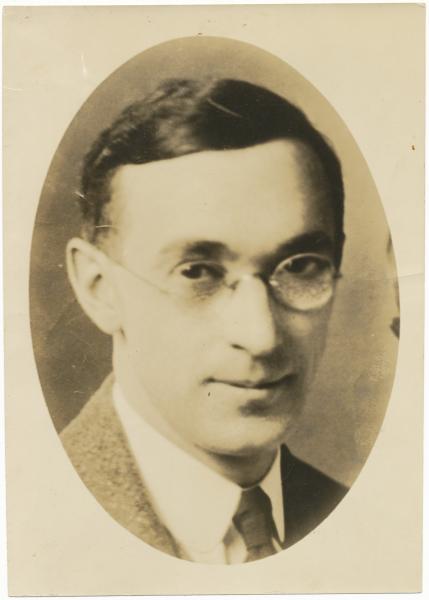
The John J. Burns Library at Boston College is pleased to announce the completion of a yearlong backlog processing project, resulting in the processing of over 415 linear feet of manuscript collections related to Boston history. Collections now available include: the records of John Donnelly & Sons, one of the most prominent outdoor advertising companies on the east coast; the personal and professional papers of penologist Howard Belding Gill, superintendent of Norfolk Prison Colony from 1927-1934 and founder and director of the Institute of Correctional Administration in Washington DC; the New England Deaconess Hospital School of Nursing records, documenting the school’s history from its inception in 1896 to its closure in 1989; the Citywide Coordinating Council records, detailing the activities of the independent, autonomous body created by the courts to oversee desegregation in Boston Public Schools, 1975-1978; and the Elizabeth Hayward collection of Ursuline Academy materials, containing materials relating to the August 11, 1834 burning of the convent and school by an anti-Catholic mob, including unpublished firsthand accounts. The Hayward collection has been completely digitized and is fully available online; you can explore finding aids for all of the recently processed collections. For more information, contact the Burns Library at burnsref@bc.edu or 617-552-4861, or see our Libguide.
Submitted by Adrienne Pruitt, Processing Archivist, John J. Burns Library, Boston College.
On March 25th of this year, the OHSU Historical Collections & Archives began the process of boxing up the records of an important collection: The Oregon Child Growth Study and the papers of Dr. Bhim Sen Savara, Principal Investigator on the project. The collection had been stored for years in the basement of the School of Dentistry, between the generators and the bomb shelter.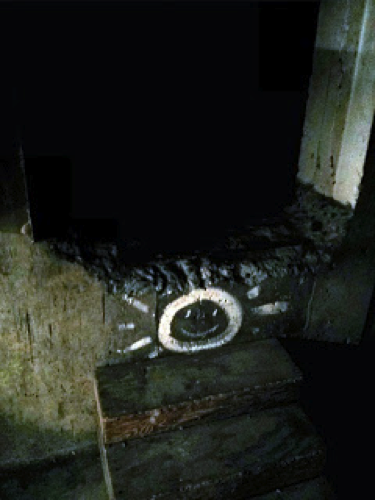
The materials document a study that was conducted from the 1950’s through the 1980’s. The records are part of a very limited, very unique, yet incredibly in-depth and extensive study on early childhood development. The unique nature of these materials means that access to the collection is a strong priority, with continuing high use anticipated. The study was so well-documented that a monograph was published discussing the process and results. This volume was also included in the acquisition.
The Crew
The group tasked with boxing up the collections and preparing them for transfer to HC&A was headed by Karen Peterson, Assistant Professor and OHSU Archivist. Assisting were Max Johnson, HC&A Student Assistant; Jeff Colby, HC&A Assistant, who helped out in the afternoons; and HC&A Student Assistant Amy Frazier, who also pitched in. HC&A also received amazing help from current dental students, Vini Colasurdo and first-year dental student Seth Hinckley.
The Materials
Preparing the records and fragile materials in order to safely move them to the Archives was the primary goal of the team. The records consist of around 350 plaster casts of jaws, over 400 binders of patient data, no less than 60 linear feet of negatives and prints, and a variety of instruments, human remains and articles related to the study. In addition, we appraised, retrieved and boxed all of Dr. Savara’s files which included three 4’ high file cabinets of materials.
All of the materials were covered in a thick layer of dust which became airborne upon physical contact. We used document-sensitive wipes and a vacuum to remove the major levels of dust prior to boxing and packing.
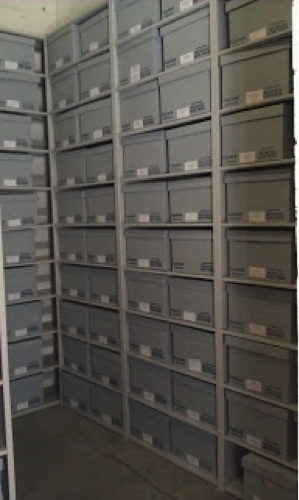 The Process
The Process
Starting with the dental casts, Vini and Seth removed the dust layers from each of the boxes, placed them archival document boxes, and then stuffed them with acid-free tissue for transfer. Once the casts were complete, we moved on to the binders. Initially we believed the binders would fit in our storage cartons, however the binders were too large - we ended up removing the documents and radiographs completely and foldering the contents in situ in order to protect them.
Jeff and Max continued to bring more storage supplies to help deal with the massive amount of photos and negatives. Max boxed up the negatives and Jeff worked on deconstructing the binders.
On the second day, we continued to box up the materials, Max learned how to pop a lock using a screw driver to access some negatives, along with the moulds and the materials in binders, and we boxed and inventoried fetus skulls that were a part of the study.
The remainder of the first week entailed finishing up the binders and beginning the process of boxing up and inventorying Dr. Savara’s files. Almost the entirety was prepared by Friday afternoon.
We finished up the last few details on Monday, including inventorying and boxing the last of the file cabinets, cleaning the space (campsite rule), bringing leftover preservation materials back up to the library and finalizing the master inventory.
Finally, on June 6th the collection was relocated to its new home in the “Old Library”. Moving the collection from the School of Dentistry to our newly outfitted stacks space was an all-day affair. Thanks to expert coordination between Karen, SOD staff, and OHSU Logistics, everything went without a hitch! We are now prepared for our first researcher already scheduled in July.
Photos and text by Max Johnson, Maija Anderson and Karen Peterson
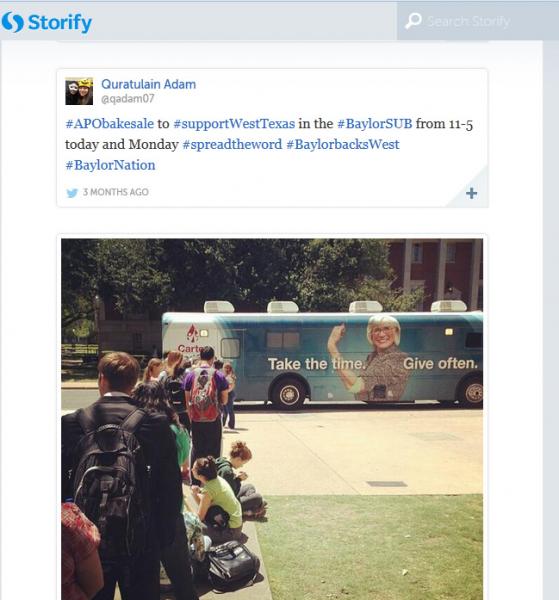
The Texas Collection at Baylor University is experimenting with adding Storify to its existing social media program. When the West Fertilizer Co. plant exploded on April 17, 2013, the Baylor community sprung into action to serve this community located about 20 miles north of campus. Social media outlets immediately lit up with messages of condolences and prayer, Baylor created a website to serve as a clearinghouse of information for ways to support West, and many faculty, staff, and students contributed by giving to supply and blood drives, helping clear debris, counseling those affected by the explosion, and other tasks as needed.
Following the first responders’ memorial service (held on the Baylor campus, a week after the explosion), The Texas Collection published “Baylor responds to the West Fertilizer plant explosion” on Storify, a program which allows users to capture and curate Facebook, Twitter, YouTube posts, website links, and other Web applications. We promoted the Storify piece via our blog, Facebook, and Twitter, and the Storify application also provides the option to notify via Twitter users who were “quoted” in the Storify piece. Five of those Twitter users favorite or retweeted that notification, and as of July 7, nearly 800 people had seen our Storify post, most of them coming to the site via our blog. This response makes us eager to continue using Storify to document university life and major events in the life of the university.
While The Texas Collection doesn’t plan at this time to use Storify as regularly as we use platforms like Facebook and Twitter, it does seem to lend itself well to occasions like the West explosion wherein the social media response is such a significant part of the story. Future Storifys might include one about Baylor’s Line Camp program for freshman, athletic accomplishments, Homecoming, and other events that are well-documented by those using social media. If other college or university archives are using Storify, please contact Amanda Norman, as we would love to discuss how you are implementing the application.
Submitted by Amanda Norman, University Archivist, The Texas Collection, Baylor University.
Commencement Programs Now Available Online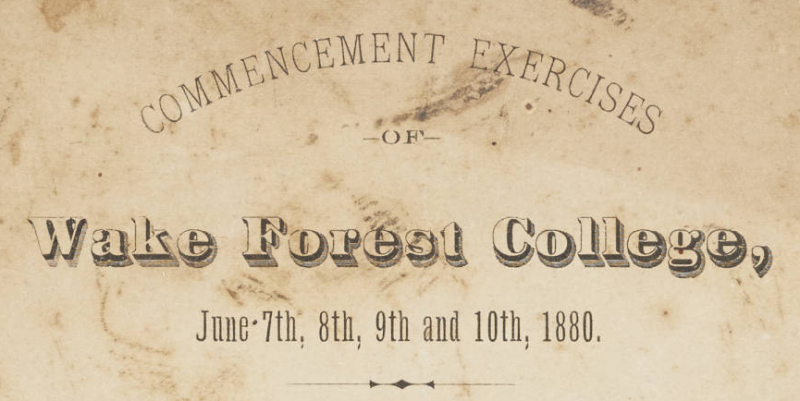
The Wake Forest University Special Collections and Archives department is happy to announce that our collection of Commencement Programs has been digitized as part of the Digital North Carolina project, and are now available online! This is the third installment of materials that has been added to the project, which already included our yearbooks, The Howler, and the Wake Forest University Bulletins and Catalogs. The programs span from 1840-present, and are a wonderful resource. Researchers can find who delivered the commencement speech, dates for the events, graduates’ names, and who graduated with honors. The programs also show how the events and ceremonies have changed over the years, as well as the special elements that have been carried over through the decades. One of our most requested collections, the Commencement Programs contain a wealth of information in just a few pages.
Wake Forest University Special Collections and Archives receives Davis C. Woolley Award for Outstanding Achievement in Assessing and Preserving Baptist History
The Special Collections & Archives Department, located in the Z. Smith Reynolds Library at Wake Forest University, has been awarded the Davis C. Woolley Award for Achievement in Assessing and Preserving Baptist History.
Presented by the president of the Society on May 22 during the annual meeting of the Baptist History and Heritage Society, the award is given to an individual or a state program that demonstrated great progress and achievements during the preceding calendar year.
The North Carolina Baptist Historical Collection at Wake Forest (also known as the Ethel Taylor Crittenden Collection in Baptist History) documents the history of North Carolina Baptist churches, institutions, and individuals. The collection contains materials on Southern, Missionary, Primitive, African-American, Union and Alliance of Baptist churches. These materials include over 16,000 books, periodicals, association annuals and other printed materials. In addition, there are more than 1,000 biographical folders containing information on and photographs of Baptist pastors and Wake Forest alumni.
Davis C. Woolley served as the second executive secretary-treasurer of the Historical Commission of the Southern Baptist Convention from 1959 to 1971. In his honor, the Historical Commission established the Davis C. Woolley Award in 1991. The purpose of the award is to encourage creativity and excellence in state Baptist history programs, including all organizations involved in assessing and preserving Baptist history.
The Baptist History and Heritage Society is a non-profit, national, independent, diverse organization of Baptist historians and other individuals and partner institutions committed to communicating the story of Baptists through the study, interpretation, publication and advocacy of Baptist history.
Henlee Hulix Barnette Papers Finding Aid Complete
Special Collections and Archives is overjoyed to announce the completion of the Henlee Hulix Barnette Papers finding aid. This finding aid has been a long time coming and we are thrilled to have it finished.
Housed in 91 boxes and covering sixteen different series of categories, the Henlee Barnette papers cover many topics of great importance during the second half of the Twentieth Century. Barnette was a Wake Forest College alumnus, a professor of Christian Ethics at Southern Baptist Seminary, a civil rights activist, a prolific author and speaker, a loyal husband and father, a clinical psychologist, and a political enthusiast among many other things. These topics and others are now available for researchers accessing his personal and professional papers.
Hoffmann Photo Digital Collection
Z. Smith Reynolds Library Special Collections & Archives is pleased to announce the completion of an exciting digital project. The Max and Gertrude Hoffmann Photograph Collection gives users a glimpse into the world of vaudeville, traveling dance troupes, and the “show biz” lifestyle of the early Twentieth Century in Europe and America. The Max and Gertrude Hoffmann Papers finding aid as well as The Max and Gertrude Hoffmann Music Manuscript Collection is also available online.
Submitted by Vicki Johnson and Rebecca Petersen, Wake Forest University.
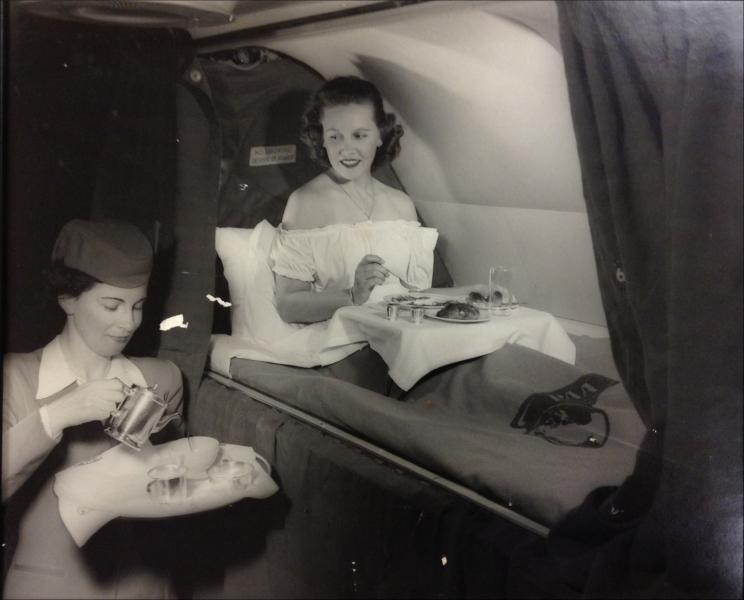
The University of Miami is steadily processing the Pan American World Airways, Inc. records, thanks to a grant from the National Historical Publications and Records Commission. The first step was to convert the 938-page container list for the 1,600-box collection into an excel spreadsheet. Next, folder headings were decoded for themes and seventeen series identified ranging from “Disasters” to “Military Cooperation.”
As original order was all but absent, series were based on provenance, common topics of interest established by research requests, simplicity, and the descriptiveness, or keyword searchability, of folder headings. Within those seventeen series, over one hundred and fifty subseries have been identified. Measuring the extents of each of these subseries has revealed an interesting thematic map of the collection.
Currently, we’re physically rearranging the collection. Keeping the collection open to researchers and tracking location information have been our biggest challenges so far. The Pan Am records is heavily used, receiving fifty percent of all research requests, making it important to keep the collection open during processing. Furthermore, researchers have been using the collection since we acquired it in 1992, making the tracking of location information vital to researchers who are following citation information.
Positive feedback from researchers and the richness of the collection keep us highly motivated as we sort the collection one folder at a time. Every box contains a treasure, like fabric samples for the interior of the Boeing 314, photographs of clear-complexioned flight attendants assisting glamorous-looking passengers of early aircraft, and most notably the scrapbook of famed and ill-fated pilot Edwin Musik.
Further processing updates and anecdotes can be found through the University of Miami Special Collections blog in the Pan Am Dispatches column. Please direct questions or comments to Emily Gibson, Visiting Archivist for the Pan American World Airways, Inc. records.
Submitted by Emily Gibson, University of Miami - Special Collections.
The past 6 months have seen a flurry of activity in University Archives & Special Collections (UASC) in the Joseph P. Healey Library at the University of Massachusetts Boston.
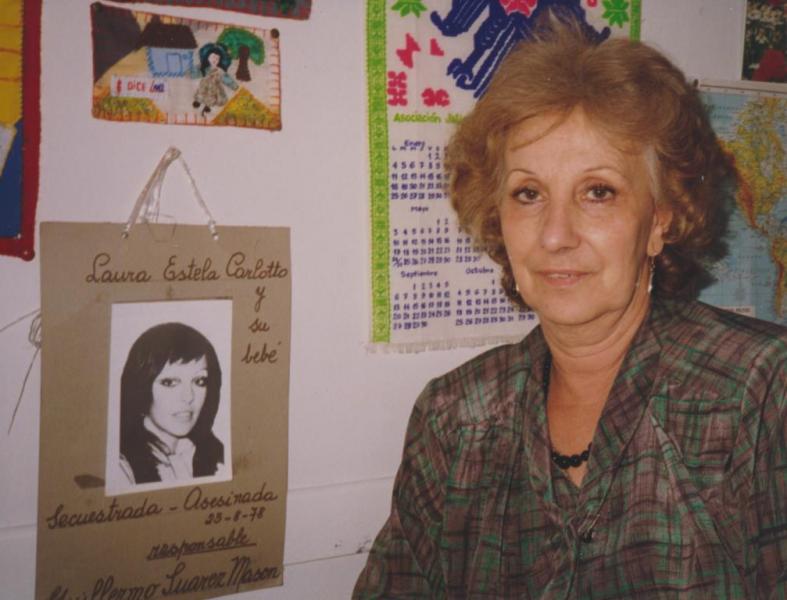 On exhibition and online
On exhibition and online
In April 2013, UASC opened an exhibition entitled “Nunca Más”: Niños Desaparecidos en Argentina y Las Abuelas de Plaza de Mayo (“Never Again”: Disappeared Children in Argentina and the Grandmothers of the Plaza de Mayo). The exhibition opened as part of an event celebrating of the life and work of biologist and human rights activist Rita Arditti and her many donations to the Library at UMass Boston.
The Grandmothers of the Plaza de Mayo is a human rights organization founded in 1977 to search for children who were abducted during the Dirty War in Argentina. Arditti interviewed the Grandmothers in the 1990s and spoke about their work until her death in 2009. The Rita Arditti Collection, donated to UASC in 2011, contains audio files, interview transcriptions, and photographs of the Grandmothers, and is available on the department’s digital collections site.
The exhibition includes photographs, interview excerpts in Spanish, and English translations. It will be on display in the Library’s Grossmann Gallery into the fall. On September 19, 2013, UASC will host an event featuring two founding members of the Abuelas.
New collections
Two recent additions to our Special Collections are the organizational records of Public Responsibility in Medicine and Research (PRIM&R) and the extensive film outtakes from the Academy Award-winning documentary Hearts and Minds.
Since its founding in 1974, PRIM&R has been at the forefront of education and policy analysis around issues of ethics, medicine, and research. The 55 boxes that constitute the organization’s records are a welcome addition to Special Collections and we look forward to making them fully available later this year.
Another important acquisition is the film outtakes from the Academy Award-winning Vietnam War documentary Hearts and Minds (1974). Director Peter Davis examined the formation and internalization of political beliefs about the war, based on an expansive series of interviews with influential political figures of the period, soldiers, veterans, civilians, and Vietnamese citizens. Processing of the more than 1,400 elements comprising the outtakes footage will begin later this year.
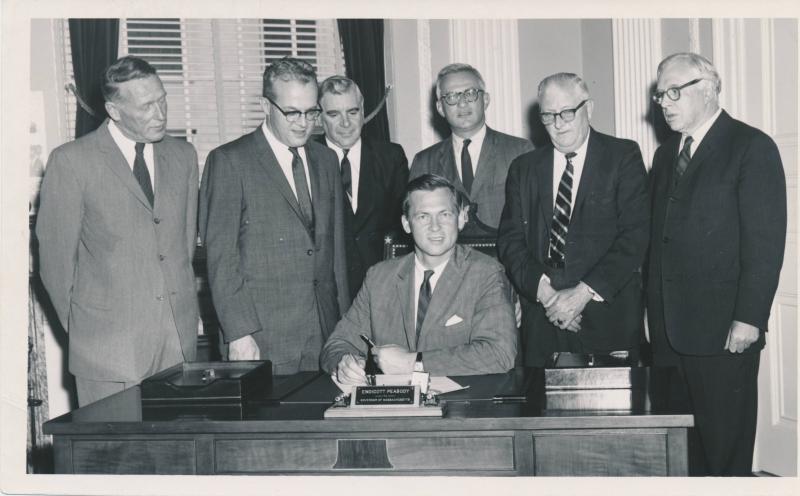 University Archives and UMass Boston’s 50th Anniversary
University Archives and UMass Boston’s 50th Anniversary
UMass Boston was established in 1964 as the second campus in the University of Massachusetts system and will celebrate its 50th anniversary next year. The University Archives has launched a number of initiatives with the aim of further building upon our existing collections of University-related records and histories. Early in 2013, the University Archives began digitizing photographs that document the first 50 years of UMass Boston. These photographs are available on our digital collections site. In the coming months, the University Archives will introduce an online system for collecting stories, photographs, and videos of UMass Boston community members.
Visit the website for announcements about these collections and our efforts to make them publicly available.
Submitted by Andrew Elder, Digital Archives and Outreach Librarian, UMass Boston.
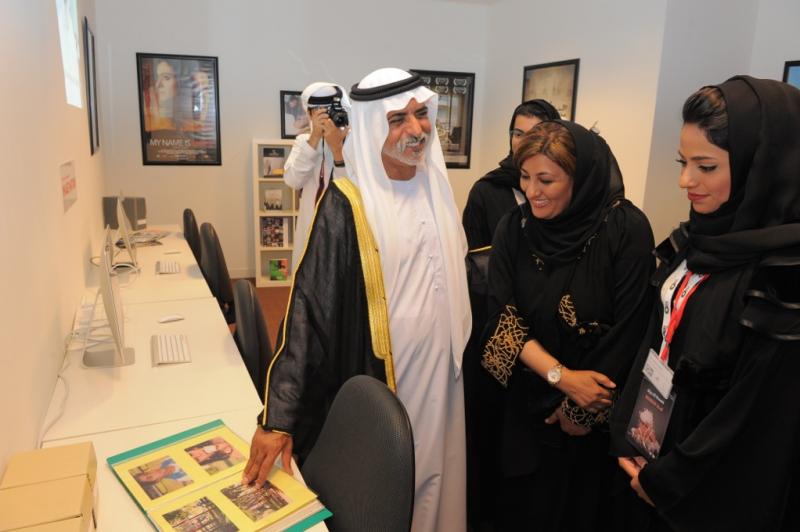 Film Archive and Library Launched at Abu Dhabi Campus
Film Archive and Library Launched at Abu Dhabi CampusThe first film archive and library in the Gulf region was inaugurated this year by Shaikh Nahyan Bin Mubarak Al Nahyan, Minister of Culture, Youth, and Community Development, at the conclusion of the Zayed University Middle East Film Festival. The two-day festival was held from April 29-30.
The project marks the first ever documenting the evolution of the United Arab Emirates film industry. The archive will provide a permanent home for Emirati-funded films for generations to come and will also benefit researchers.
The UAE National Film Library and Archive (UNFLA) boasts a film database that includes entries to the Abu Dhabi Film Festival (ADFF), Dubai International Film Festival (DIFF), Gulf Film Festival, Zayed University Middle East Film Festival and Emirates Film Competition which is devoted to short films from the UAE and GCC countries. The film database is a highlight of the Zayed University library catalogue.
The UNFLA team leader, Alia Yunis, who teaches film studies, began to realize when working with the local film community how much had been lost of UAE-made films and related materials, and that no one was actively attempting to collect them. She and her colleague Ozge Calafato (formerly with the Abu Dhabi Film Festival) reached out to filmmakers as grant funding and support from the university were secured. Drawing from the Dubai and Abu Dhabi film festival catalogs from years past, and extensive outreach with the help of students, they began to gather the foundation of the film collection, nearly 400 films. On the archives side, Heidi Butler developed a metadata scheme and advised on organization and storage of the physical materials collected, helped to get a pilot database online, and managed and contributed to the UNFLA web presence. The librarian on the team, David, helped review films for quality, gathered media clippings and links, and has served as the liaison for visitors and researchers.
In addition to at least one access copy of all books and films, the film archive preserves master original print films, master digital film versions, scripts, dialogue lists for translation/subtitling, press kits, media materials (newspaper clippings, interviews, magazine articles), trailers, production stills, written or recorded interviews (oral histories) from filmmakers, actors, and others, especially from the earliest UAE productions, besides posters, flyers, brochures and schedules.
The material will become a part of the circulating or other in-house library collections at Zayed University. At least one copy will be located in the Abu Dhabi Audio-visual Collection; others may be added to the Emirates Collection. Copies may also be placed in the Dubai Library, according to the university.
The Zayed University Middle East Film Festival began in 2010 as a student graduation project. It continues to be organised by a Zayed University class, which oversees all marketing, film evaluation, event organisation, and other work.
Submitted by Heidi Butler, University Archivist, Zayed University, Dubai.
Nature.com and the German version of Scientific American(under the umbrella of the Nature Publishing Group) officially launched Shannon Bohle's blog "Scientific and Medical Libraries" on their SciLogs website. Her first article, "Librarians and the Era of the MOOC," discussed how librarians and other information professionals are learning to facilitate STEM professors and students working in this modern, adapted form of online education. Praised or scorned in monolithic publications like the NYT,Time, and The Chronicle of Higher Education, MOOCs emerged as a noticeable disruption to the educational establishment due to their enormous participation, sometimes with enrollment rates numbering in the tens or hundreds of thousands. University administrators are grappling with the question about how they can best leverage MOOC courses. Because many of the subjects taught are in computer science, medicine, and other STEM areas, science and medical librarians/archivists need to familiarize themselves with this new teaching and learning format, including format-specific issues pertaining to information literacy, copyright restrictions, and reference services for these massive courses. Subsequent pieces have focused on topics such as the dramatic changes related to Open Access, Open Data, and e-science.
Those interested in trends, issues and changes affecting library/archival materials in medicine and the sciences, can follow Shannon's blog or follow her on Twitter @SciMedLibraries.
Submitted by Shannon Bohle.